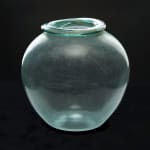Roman
Provenance
Sotheby's London, 13 - 14 July 1981, lot 463With Asprey, London, circa 1986-1989
With Rupert Wace Ancient Art, London before 2006
Private collection, Switzerland, acquired in 2006
Literature
This type of jar has been found largely in Europe, in the middle and north of the Roman empire. There have been numerous documented finds from Italy, Germany, the Netherlands, France, and Britain. The natural assumption is that this type of glass was manufactured in those countries and that the limited finds across the rest of the Roman empire must thus be exported goods. Such large glass jars were used as storage vessels and this is known from finds in Pompeii, Herculaneum, Boscoreale, and Settefinestre. However they were also employed for cremation and the jars used for this purpose have survived the centuries in exceptionally good condition, or even intact such as this example, an occurrence which would otherwise be highly unusual for glass of this size.
The jar corresponds to Isings form 67a. Often such urns had matching glass lids but this example is unusual in that its lid was made of lead and it has survived. For the type, see C. Isings, Roman Glass from Dated Finds, Groningen, 1957, pp. 86-7; D. Whitehouse, Roman Glass in The Corning Museum of Glass, vol.1, Corning, 1997, p. 175, no. 307. For a cinerarium with a lead container and lid, cf. E.M. Stern & B. Schlick-Nolte, Early Glass of the Ancient World 1600 BC - AD 50. Ernesto Wolf Collection, Germany, 1994, no. 42.



